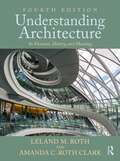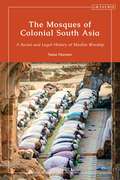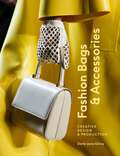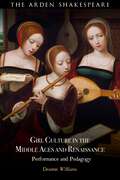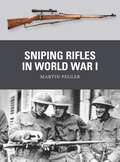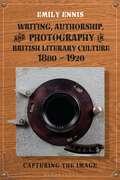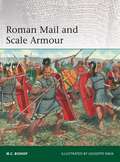- Table View
- List View
Computer Vision: Challenges, Trends, and Opportunities (Chapman & Hall/CRC Computer Vision)
Computer vision has made enormous progress in recent years, and its applications are multifaceted and growing quickly, while many challenges still remain. This book brings together a range of leading researchers to examine a wide variety of research directions, challenges, and prospects for computer vision and its applications.This book highlights various core challenges as well as solutions by leading researchers in the field. It covers such important topics as data-driven AI, biometrics, digital forensics, healthcare, robotics, entertainment and XR, autonomous driving, sports analytics, and neuromorphic computing, covering both academic and industry R&D perspectives. Providing a mix of breadth and depth, this book will have an impact across the fields of computer vision, imaging, and AI.Computer Vision: Challenges, Trends, and Opportunities covers timely and important aspects of computer vision and its applications, highlighting the challenges ahead and providing a range of perspectives from top researchers around the world. A substantial compilation of ideas and state-of-the-art solutions, it will be of great benefit to students, researchers, and industry practitioners.
Giving Voice: The Power of Theatre for Positive Change (ISSN)
by Carol J. MaplesThis book is a practical guide for using the power of theatre to address issues of oppression in areas such as race, ethnicity, LGBTQ+, gender, and sexual harassment.Giving Voice charts a roadmap for the process of establishing a troupe, including auditioning members, utilizing authentic source material, directing rehearsals, guiding mindful growth among troupe members, and facilitating an inclusive forum environment. Rooted in Augusto Boal’s Theatre of the Opressed and using the nationally recognized Missouri State University’s Giving Voice troupe as a model, this book provides guidance for customizing the program’s principles to meet the needs of your school, community, organization, or business. Giving Voice forums bring professional development to a new level. Applications include diversity and cultural awareness training in educational settings for students, staff, faculty, and administrators, as well as those in non-profit and for-profit organizations.This book provides a powerful and proven approach to creating a truly inclusive climate. It is a guidebook for accessible use in the secondary and university setting in theatre and performance studies. It has also been shown to be effective for businesses and other organizations.
Giving Voice: The Power of Theatre for Positive Change (ISSN)
by Carol J. MaplesThis book is a practical guide for using the power of theatre to address issues of oppression in areas such as race, ethnicity, LGBTQ+, gender, and sexual harassment.Giving Voice charts a roadmap for the process of establishing a troupe, including auditioning members, utilizing authentic source material, directing rehearsals, guiding mindful growth among troupe members, and facilitating an inclusive forum environment. Rooted in Augusto Boal’s Theatre of the Opressed and using the nationally recognized Missouri State University’s Giving Voice troupe as a model, this book provides guidance for customizing the program’s principles to meet the needs of your school, community, organization, or business. Giving Voice forums bring professional development to a new level. Applications include diversity and cultural awareness training in educational settings for students, staff, faculty, and administrators, as well as those in non-profit and for-profit organizations.This book provides a powerful and proven approach to creating a truly inclusive climate. It is a guidebook for accessible use in the secondary and university setting in theatre and performance studies. It has also been shown to be effective for businesses and other organizations.
Inclusive, Sustainable, and Transformational Education in Arts and Literature: Proceedings of the 7th International Seminar on Language, Education, and Culture, (ISoLEC, 2023), July 07—08, 2023, Malang, Indonesia
This book contains the proceedings of The International Seminar on Language, Education, and Culture (ISoLEC) 2023, an annual conference hosted by the Faculty of Letters, Universitas Negeri Malang. With the theme, Inclusive, Sustainable, and Transformational Education in Arts and Literature, ISoLEC aims to address key issues such as inclusive education in language, arts, and culture, sustainable education in language, arts, and culture, post-pandemic teaching and learning practices, corpus-based language, teaching and research, language in media, gender and identity, pop contemporary and digital culture, culture and spirituality, multilingualism and translanguaging, visual and performing arts, oral tradition and local culture, and digital literacy and information science. This book is a collection of selected articles that were presented at the conference covering issues of arts, language, and cultures. This conference addressed a range of relevant topics including:· Inclusive Education in Language, Arts, & Culture· Sustainable Education in Language, Arts, & Culture· Post Pandemic Teaching and Learning Practices· Corpus-Based Language, Teaching and Research· Language in Media· Gender and Identity· Pop, Contemporary and Digital Culture· Culture and Spirituality· Multilingualism and Translanguaging· Visual and Performing Arts· Oral Tradition & Local Culture· Digital Literacy and Information ScienceThis proceeding will be of interest to students, lecturers, teachers, and academics who are interested in developing their knowledge in the field of language, education, and culture. Specifically, this book will be an interesting read for those who want to reimagine the inclusive and sustainable education.
Inclusive, Sustainable, and Transformational Education in Arts and Literature: Proceedings of the 7th International Seminar on Language, Education, and Culture, (ISoLEC, 2023), July 07—08, 2023, Malang, Indonesia
by Sari Karmina Kusubakti Andajani Lidya Amalia RahmaniaThis book contains the proceedings of The International Seminar on Language, Education, and Culture (ISoLEC) 2023, an annual conference hosted by the Faculty of Letters, Universitas Negeri Malang. With the theme, Inclusive, Sustainable, and Transformational Education in Arts and Literature, ISoLEC aims to address key issues such as inclusive education in language, arts, and culture, sustainable education in language, arts, and culture, post-pandemic teaching and learning practices, corpus-based language, teaching and research, language in media, gender and identity, pop contemporary and digital culture, culture and spirituality, multilingualism and translanguaging, visual and performing arts, oral tradition and local culture, and digital literacy and information science. This book is a collection of selected articles that were presented at the conference covering issues of arts, language, and cultures. This conference addressed a range of relevant topics including:· Inclusive Education in Language, Arts, & Culture· Sustainable Education in Language, Arts, & Culture· Post Pandemic Teaching and Learning Practices· Corpus-Based Language, Teaching and Research· Language in Media· Gender and Identity· Pop, Contemporary and Digital Culture· Culture and Spirituality· Multilingualism and Translanguaging· Visual and Performing Arts· Oral Tradition & Local Culture· Digital Literacy and Information ScienceThis proceeding will be of interest to students, lecturers, teachers, and academics who are interested in developing their knowledge in the field of language, education, and culture. Specifically, this book will be an interesting read for those who want to reimagine the inclusive and sustainable education.
Planning and Designing the Absent City: Campsites as Temporary Settlements
by Luca TrabattoniThis book concerns the study of open-air accommodation facilities. The market evolutions allow us to look at these structures as temporary settlements characterised by a low-density dwelling and a close connection with natural elements and the landscape.This new and different point of view is sustained by the tendency of outdoor tourism to go in the direction of temporary villages, and this tendency is directly related to "time" and "landscape". The landscape is the reason why the campsite is settled. The time is linked to the holiday season timing. Today, both are greatly influenced by the introduction of the "Maxi-Caravan". This removable living unit can be placed on the empty pitch, occupying the landscape without ruining the soil. By the settlement of Maxi-Caravans, the campsite is transformed from an empty landscape with tents to a temporary settlement, whose timing is divided between the seasonal timing of the campsite and the "timing" of the product, and whose landscape is organised by the relation with the prevalent landscape and the internal one. The book's core defines the outdoor facility structure, using Italy as the main case study. To identify design strategies, the book analyses temporary settlement examples (quick time) and projects from historic outdoor tourism (medium time). Finally, the last chapter reflects on open-air accommodation facilities by showing their applicability in the different contexts of the refugee camps (long time).The aim of this research is to enhance the theme of open-air accommodation facilities, highlighting the need to equalise the study of temporary settlements with that of permanent settlements. It will be of interest to researchers and students of planning, landscape and tourism.
Planning and Designing the Absent City: Campsites as Temporary Settlements
by Luca TrabattoniThis book concerns the study of open-air accommodation facilities. The market evolutions allow us to look at these structures as temporary settlements characterised by a low-density dwelling and a close connection with natural elements and the landscape.This new and different point of view is sustained by the tendency of outdoor tourism to go in the direction of temporary villages, and this tendency is directly related to "time" and "landscape". The landscape is the reason why the campsite is settled. The time is linked to the holiday season timing. Today, both are greatly influenced by the introduction of the "Maxi-Caravan". This removable living unit can be placed on the empty pitch, occupying the landscape without ruining the soil. By the settlement of Maxi-Caravans, the campsite is transformed from an empty landscape with tents to a temporary settlement, whose timing is divided between the seasonal timing of the campsite and the "timing" of the product, and whose landscape is organised by the relation with the prevalent landscape and the internal one. The book's core defines the outdoor facility structure, using Italy as the main case study. To identify design strategies, the book analyses temporary settlement examples (quick time) and projects from historic outdoor tourism (medium time). Finally, the last chapter reflects on open-air accommodation facilities by showing their applicability in the different contexts of the refugee camps (long time).The aim of this research is to enhance the theme of open-air accommodation facilities, highlighting the need to equalise the study of temporary settlements with that of permanent settlements. It will be of interest to researchers and students of planning, landscape and tourism.
The Self-Sustaining Filmmaker: Creating Crowdsourced, Crowdfunded & Community-Supported Independent Film
by Marty LangThis book provides guidance on how to build an independent, financially sustainable filmmaking career through channels such as crowdsourcing, crowdfunding, and community filmmaking concepts.Through real-life experiences, Marty Lang provides insight on how to use these key concepts through every stage of a film’s lifecycle – from distribution (the stage that should be figured out first), through development, screenwriting, prep, production and post, all the way through marketing and the film’s release. By thinking of filmmaking as a start-up company, and looking at how businesses make money, Lang creates a completely independent financial model for films, turning filmmakers into businesspeople, conscious of the needs of their audiences, and empowered to use their creative work to make their living. Using interviews with leaders in the field, case studies, and practical experience gained from 20 years of community filmmaking, this book unveils an exciting, new way to make films that prioritizes a collaborative, entrepreneurial mindset at every stage.This is an essential guide for aspiring and seasoned filmmakers alike looking to understand and apply crowdsourcing as an effective tool in their career.
The Self-Sustaining Filmmaker: Creating Crowdsourced, Crowdfunded & Community-Supported Independent Film
by Marty LangThis book provides guidance on how to build an independent, financially sustainable filmmaking career through channels such as crowdsourcing, crowdfunding, and community filmmaking concepts.Through real-life experiences, Marty Lang provides insight on how to use these key concepts through every stage of a film’s lifecycle – from distribution (the stage that should be figured out first), through development, screenwriting, prep, production and post, all the way through marketing and the film’s release. By thinking of filmmaking as a start-up company, and looking at how businesses make money, Lang creates a completely independent financial model for films, turning filmmakers into businesspeople, conscious of the needs of their audiences, and empowered to use their creative work to make their living. Using interviews with leaders in the field, case studies, and practical experience gained from 20 years of community filmmaking, this book unveils an exciting, new way to make films that prioritizes a collaborative, entrepreneurial mindset at every stage.This is an essential guide for aspiring and seasoned filmmakers alike looking to understand and apply crowdsourcing as an effective tool in their career.
Television Sitcom and Cultural Crisis (Routledge Advances in Television Studies)
This volume demonstrates that television comedies are conduits through which we might resist normative ways of thinking about cultural crises.By drawing on Gramscian notion of crisis and the understanding that crises are overlapping, interconnected, and mutually constitutive, the essays in this collection demonstrate that situation comedies do more than make us laugh; they also help us understand the complexities of our social world’s moments of crisis. Each chapter takes up the televisual representation of a modern cultural crisis in a contemporary sitcom and is grounded in the extensive body of literature that suggests that levity is a powerful mechanism to make sense of and cope with these difficult cultural experiences.Divided into thematic sections that highlight crises of institutions and systems, identity and representation, and speculation and futurism, this book will interest scholars of media and cultural studies, political economy, communication studies, and humor studies.
Television Sitcom and Cultural Crisis (Routledge Advances in Television Studies)
by Holly Willson Holladay Chandler L. ClassenThis volume demonstrates that television comedies are conduits through which we might resist normative ways of thinking about cultural crises.By drawing on Gramscian notion of crisis and the understanding that crises are overlapping, interconnected, and mutually constitutive, the essays in this collection demonstrate that situation comedies do more than make us laugh; they also help us understand the complexities of our social world’s moments of crisis. Each chapter takes up the televisual representation of a modern cultural crisis in a contemporary sitcom and is grounded in the extensive body of literature that suggests that levity is a powerful mechanism to make sense of and cope with these difficult cultural experiences.Divided into thematic sections that highlight crises of institutions and systems, identity and representation, and speculation and futurism, this book will interest scholars of media and cultural studies, political economy, communication studies, and humor studies.
Understanding Architecture Its Elements, History, and Meaning: Its Elements, History, And Meaning
by Leland M. Roth Amanda C. Roth ClarkThe widely acclaimed and beautifully illustrated Understanding Architecture is now revised and expanded in its fourth edition, vividly examining the structure, function, history, and meaning of architecture, from prehistory to the present, in ways that are both accessible and engaging.
The Mosques of Colonial South Asia: A Social and Legal History of Muslim Worship (Library of Islamic South Asia)
by Sana HaroonIn a series of legal battles starting in 1882, South Asian Muslims made up of modernists, traditionalists, reformists, Shias and Sunnis attempted to modify the laws relating to their places of worship. Their efforts failed as the ideals they presented flew in the face of colonial secularism. This book looks at the legal history of Muslim endowments and the intellectual and social history of sectarian identities, demonstrating how these topics are interconnected in ways that affected the everyday lives of mosque congregants across North India. Through the use of legal records, archives and multiple case studies Sana Haroon ties a series of narrative threads stretching across multiple regions in Colonial South Asia.
Fashion Bags and Accessories: Creative Design and Production
by Darla-Jane GilroyFashion Bags and Accessories explores fashion bags and related accessories, such as purses, wallets, clutches, cases, gloves and belts, through various approaches to creative design, product development, technological innovation, materials development, component design (hardware) and branding. Readers will become familiar with key constructions and gain grounding in both traditional craft-making techniques and contemporary digital manufacturing process. Traditional accessory materials like leather are considered alongside new and emerging sustainable materials. Key elements of fashion bags and accessories like component design, signature branding and logo design are also covered in depth. Primarily aimed at students on fashion design, product design, or specialized accessories courses, the book will also be a go-to reference for professionals wishing to move into or evolve in this product area.
Girl Culture in the Middle Ages and Renaissance: Performance and Pedagogy
by Deanne WilliamsDeanne Williams offers the very first study of the medieval and early modern girl actor. Whereas previous histories of the actress begin with the Restoration, this book demonstrates that the girl is actually a well-documented category of performer and a key participant in the drama of the Middle Ages and Renaissance. It explores evidence of the girl actor in archival records of payment, eyewitness accounts, stage directions, paintings, and in the plays and masques that were explicitly composed for girls, and, in some cases, by them.Contradicting previous scholarly assumptions about the early modern stage as male-dominated, this evidence reveals girls' participation in medieval religious drama, Tudor civic pageants and royal entries, Elizabethan country house entertainments, and Stuart court and household masques. This book situates its historical study of the girl actor within the wider contexts of 'girl culture', including girls as singers, translators and authors. By examining the impact of the girl actor on constructions of girlhood in the work of Shakespeare – whose girl characters register and evoke the power of the performing girl – Girl Culture in the Middle Ages and Renaissance argues that girls' dramatic, musical and literary performances actively shaped medieval and early modern culture. It shows how the active presence and participation of girls shaped medieval and Renaissance culture, and it reveals how some of its best-known literary and dramatic texts address, represent, and reflect upon girl children, not as an imagined ideal, but as a lived reality.
Sniping Rifles in World War I (Weapon)
by Martin PeglerWhile Germany and Austria-Hungary were well-equipped with sniping rifles in 1914, their Allied opponents were not. This highly illustrated volume tells the inside story of the rifles carried by snipers of all the major powers during World War I.Although military sharpshooting had existed since the 18th century, in 1914 only the German and Austro-Hungarian armies fielded trained snipers armed with scoped rifles. Thus upon the outbreak of World War I, the Allied armies found themselves on the receiving end of a shooting war to which they had no means of response. Only the Canadians brought a dedicated sniping rifle into the trenches, but in small numbers. For the British, although production of a suitable rifle and scope were settled on quickly, the establishment of sniper training was difficult and its success was mostly due to the efforts of a handful of dedicated officers. The French eventually introduced a competent scoped rifle and a sniper training system, as did the Italians. Entering the war in 1917, the Americans experienced rifle shortages but were able to build on their pre-1914 efforts to find a suitable sniping weapon. The country that suffered most grievously was Russia; Russian troops fielded no snipers at all and suffered accordingly. Featuring full-colour artwork, carefully chosen archive images and photographs of the sniping rifles and accessories used in the trenches, this is the inside story of the rifles carried by snipers of all the major powers during World War I.
Writing, Authorship and Photography in British Literary Culture, 1880 - 1920: Capturing the Image
by Emily EnnisAt the turn of the 20th century, printing and photographic technologies evolved rapidly, leading to the birth of mass media and the rise of the amateur photographer. Demonstrating how this development happened symbiotically with great changes in the shape of British literature, Writing, Authorship and Photography in British Literary Culture, 1880-1920 explores this co-evolution, showing that as both writing and photography became tools of mass dissemination, literary writers were forced to re-evaluate their professional and personal identities. Focusing on four key authors-Thomas Hardy, Bram Stoker, Joseph Conrad and Virginia Woolf-each of which had their own private and professional connections to photographs, this book offers valuable historical contexts for contemporary cultural developments and anxieties. At first establishing the authors' response to developing technologies through their non-fiction, personal correspondences and working drafts, Ennis moves on to examine how their perceptions of photography extend into their major works of fiction: A Laodicean, Dracula, The Secret Agent, The Inheritors and The Voyage Out. Reflecting on the first 'graphic revolution' in a world where text and image are now reproduced digitally and circulated en masse and online, Ennis redirects our attention to when image and text appeared alongside each other for the first time and the crises this sparked for authors: how they would respond to increasingly photographic depictions of everyday life, and in turn, how their writing adapted to a distinctly visual mass media.
Roman Mail and Scale Armour (Elite #252)
by M.C. BishopFully illustrated, this study investigates the origins, evolution and use of the mail and scale armour worn by the soldiers and gladiators of Imperial Rome.Less glamorous than the Roman Army's instantly recognizable plate armour but much more versatile, mail and scale armour were used by both legionaries and auxiliaries throughout Rome's history. Developed by the Celts and quickly adopted by the Romans, mail armour was easy to make and required little maintenance. Scale was a much older form of armour, originating in the Near East during the second millennium BC. As with mail, it was used by both auxiliaries and legionaries, but like plate armour, it was much more fragile than mail. Both types of armour were also used by gladiators (principally as arm defences).New discoveries in both mail and scale, as well as in hybrid forms that mixed the two, mean that much more is now known about the development of these types of defence during the Roman period, their efficacy in battle and how they were manufactured and repaired. Featuring specially commissioned artwork and drawing upon the latest findings, this study lifts the veil on the mail and scale armour used by soldiers, gladiators and others during the heyday of Imperial Rome.






